A Middle Eastern Breakfast Feast
Growing up in the Middle East, breakfast has always been a cherished meal for me. It is not just about fueling up for the day ahead, but also about starting with a profound sense of warmth and comfort. In my household, and in many others across the region, breakfast is a sacred time for families to gather and enjoy a variety of vibrant, delicious dishes.
Preparing for each meal is a cherished ritual. The table spread is a meticulous arrangement of dishes—a vibrant tapestry of colors ranging from vegetables and dairy to a hearty dose of protein. This presentation is designed to please both the eye and the palate, ensuring a lavish start to the day.
Adapting to the “on the go” breakfast culture of Los Angeles—a quick bagel or a donut with a cup of coffee—was, admittedly, a cultural shock. While this is the typical way of our work days, planning a great meal with family around a tasty feast is something rooted in our hearts.
The Heart of the Feast: Foul
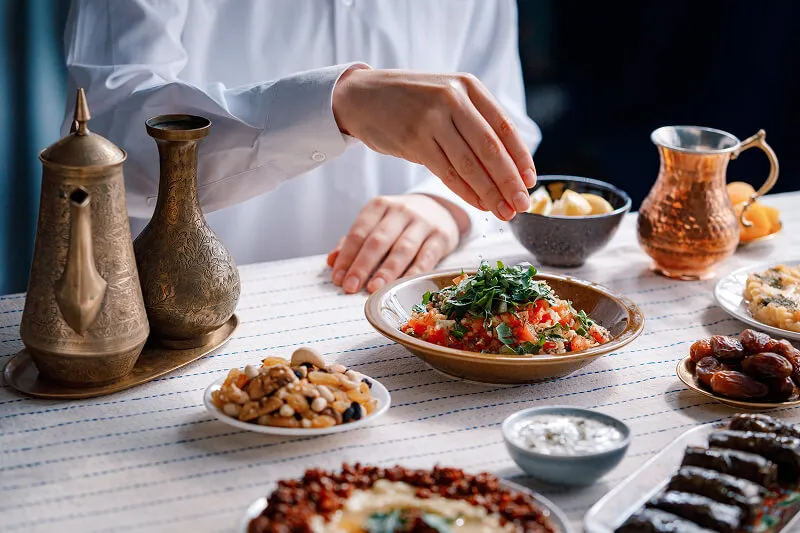
One of the most foundational Middle Eastern breakfast items is Foul (pronounced ‘fool’). It is perfect for a weekend gathering and intensely satisfying, rich in iron and nutrition. The key is to enjoy it immediately; one small bowl could sustain you for the entire day. This hearty dish is made from fava beans cooked with garlic, lemon juice, and olive oil, and is typically served with a side of fresh vegetables and bread for dipping. My favorite accompaniment is cucumber pickles.
Here is a quick recipe for Foul with a personal, homemade twist:
- 2 cups dried fava beans (canned are easily available at local markets or online)
- 4 cloves of garlic, minced
- 1/4 cup olive oil (plus extra for drizzling)
- 1/2 cup lemon juice
- Salt and Cumin to taste
- Fresh vegetables (such as cucumbers, tomatoes, green onions, sliced onions, mint, and radishes) for serving. You can also add olives and fresh parsley.
- Pita bread or other flatbread for dipping
- 1 pound Swiss chard stems
- ½ cup sesame paste
- ¼ cup water
- ¼ cup lemon juice
- 2 cloves garlic mashed
- Salt
- Parsley for garnish
Soak the dried fava beans in water overnight (or at least 8 hours). Drain and rinse.
In a large pot, add the soaked fava beans and cover with water. Bring to a boil, then reduce heat and simmer for 1–2 hours, until the beans are soft and easily mashed.
Step 3:
Drain the cooked fava beans and transfer them to a large mixing bowl. Mash the beans with a fork or potato masher until they reach a chunky consistency.
Step 4:
In a small skillet, heat the olive oil over medium heat. Add the minced garlic and cook for 1–2 minutes, until fragrant.
Step 5:
Add the garlic and olive oil mixture to the mashed fava beans. Stir in the lemon juice, salt, and cumin to taste. Mix well to combine all ingredients. Ensure the dish retains some liquid so it is not dry. Be generous with the olive oil topping. For a playful touch, add pomegranate seeds.
Tip: Add Soft Garbanzo Beans to balance the fava bean flavor. It transforms the dish into something you will savor for life.
Step 6:
Serve the foul warm or at room temperature, with fresh vegetables and pita bread for dipping.
Your table can be set with a saucer for each guest, a glass of orange juice or hot tea. Arrange a large platter of various vegetables; I highly recommend adding some green hot pepper. If you are not a pita bread lover, use crisp lettuce, cucumber slices, or fresh onion to scoop the foul. Pickles (cucumber, turnip, or cabbage) are also a great complement to elevate the table spread.
This is not your typical breakfast; it is an invitation for storytelling. Hours can pass while enjoying this cultural dish, which is universally celebrated across the Middle East and featured on menus in many hotels and restaurants. You can now master your own version and entertain an entire family with it. Many stories from my parents were told over a Foul dish. The best recipe originates from the Levant area.
Other Morning Delights
For more homemade breakfast ideas, here are additional dishes to explore for many weekends to come:
Morocan Cuisine
Cool Beans: Legumes Usher in Autumn
The World Is Your Oyster: Turkish Delights
The Sensory Souk: Tastes, Scents, & Soul of the MENA Spice Palette
The World Is Your Oyster: Turkish Delights
Knefe (For Sweet Lovers)
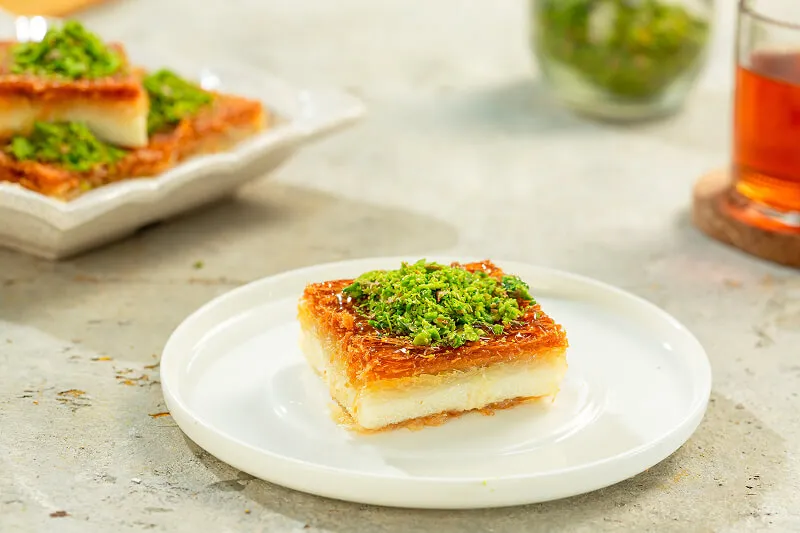
A sweet and savory pastry made with thin layers of shredded phyllo dough, cheese, and a sugary syrup. It is a decadent treat often enjoyed on special occasions.
- 1 package of shredded phyllo dough (kataifi)
- 1 cup of unsalted butter, melted
- 2 cups of shredded mozzarella cheese
- 1 cup of ricotta cheese
- 1 cup of sugar
- 1 cup of water
- 1 tablespoon of lemon juice
- 1 teaspoon of orange blossom water (optional)
- Crushed pistachios for garnish
- 1 pound premium beef filet
- 2 large onions cut into strips
- 4 tablespoons vegetable oil
- 4 tablespoons water
- 4 garlic cloves mashed
- 1 tablespoon chopped fresh iklil al jabal or rosemary
- ¼ cup chopped radish for garnish
- Salt and pepper
Preheat the oven to 350°F (175°C) and grease a 9×13-inch baking dish with butter.
Spread half of the shredded phyllo dough in the bottom of the baking dish and drizzle half of the melted butter over it. Press the dough down firmly to create a crust.
In a mixing bowl, combine the mozzarella cheese and ricotta cheese, then spread the mixture evenly over the phyllo dough crust.
Step 4:
Top the cheese mixture with the remaining shredded phyllo dough, then drizzle the rest of the melted butter over the top.
Step 5:
Bake in the preheated oven for 30-40 minutes, or until the top is golden brown.
Step 6:
While the knefe is baking, make the sugar syrup. In a saucepan, combine the sugar, water, lemon juice, and orange blossom water. Bring to a boil, then reduce heat and simmer for 10-15 minutes, until the syrup has thickened slightly.
Step 7:
Once the knefe is done baking, pour the sugar syrup over the top of the pastry while it is still hot. Allow it to soak in before cutting into squares.
Step 8:
Garnish with crushed pistachios before serving. Enjoy warm or at room temperature.
Manakesh (Savory Flatbread)
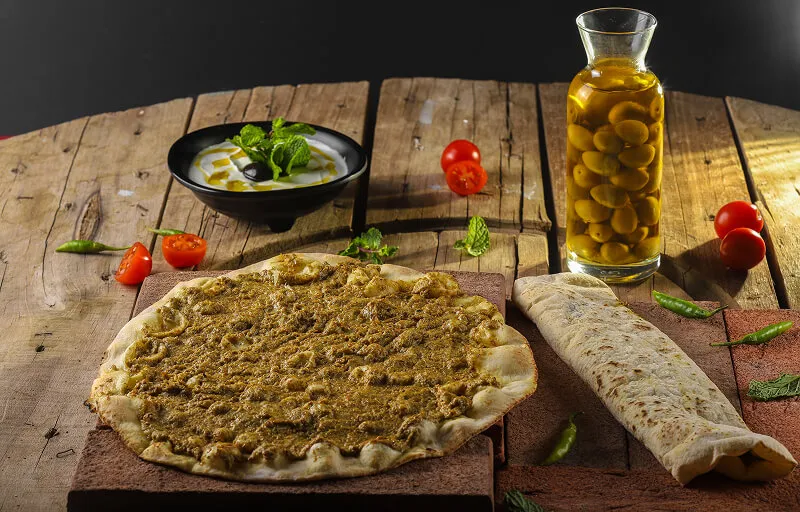
A type of flatbread topped with a variety of ingredients such as za’atar (a mixture of herbs and spices), cheese, or minced meat. It is a versatile dish enjoyed for breakfast, lunch, or dinner.
- 1 lb of pizza dough (store-bought or homemade)
- 2 tbsp of za’atar
- 1 cup of shredded cheese (such as mozzarella or feta)
- 1/2 lb of minced meat (beef or lamb)
- 1/4 cup of diced tomatoes
- 1/4 cup of diced onions
- 1/4 cup of chopped parsley
- Olive oil
- Salt and pepper to taste
Preheat your oven to 450°F (230°C).
Roll out the pizza dough on a floured surface into a large circle, about 1/4 inch thick.
Place the dough on a baking sheet lined with parchment paper.
Step 4:
Spread a thin layer of olive oil over the dough.
Step 5:
Sprinkle the za’atar evenly over the dough.
Step 6:
Top half of the dough with the shredded cheese and the other half with the minced meat, tomatoes, onions, and parsley.
Step 7:
Season with salt and pepper.
Step 8:
Bake in the preheated oven for 10-12 minutes, or until the crust is golden brown and the cheese is melted.
Step 9:
Bake in the preheated oven for 10-12 minutes, or until the crust is golden brown and the cheese is melted.
Step 10:
Bake in the preheated oven for 10-12 minutes, or until the crust is golden brown and the cheese is melted.
Kishik (Comforting Porridge)
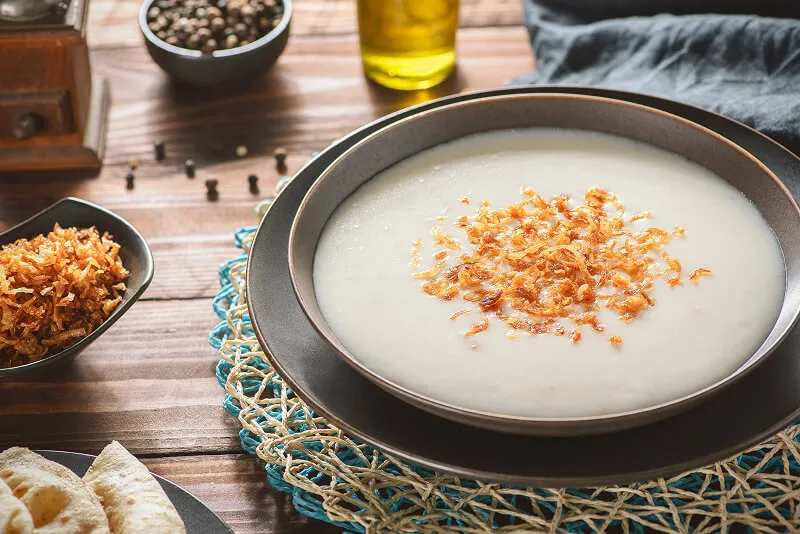
A traditional dehydrated mixture of fermented yogurt and bulgur (cracked wheat) mixture often cooked with onions and spices to create a comforting porridge-like dish. It is a popular breakfast option in many Middle Eastern countries, particularly in the Levant (Lebanon, Syria, Jordan) and Egypt. The process involves fermenting the dairy and bulgur together over several days, often kneading it daily, and then drying it—traditionally under the sun—until it becomes a rock-hard, fine powder. This makes Kishik an excellent example of mouneh, the Lebanese tradition of preserving foods for winter times.
Kishik has a distinctive, tangy, sour flavor due to the fermentation, and a slightly nutty taste from the wheat. It’s highly nutritious, combining the protein of the dairy with the carbohydrates of the bulgur.
While Kishik is distinctively Arabic, the combination of fermented dairy and grains for preservation and consumption is a theme that recurs in many cultures across the globe, such as Tarhana in Turkey, Greece, and the Balkans. Tarhana often includes vegetables (like tomatoes, peppers, or onions) and herbs mixed into the dough before drying, giving it a broader range of flavors than the typical Kishik. While both are used in soups, Tarhana is more often associated with Turkish and Greek cuisines.
Similar to Kishik are the Fermented Cereal Porridges and Soups from Africa and India. Various African cultures have traditional fermented cereal-based foods, often consumed as porridge or beverages. Uji (Kenya) or Ogi (Nigeria) are also fermented porridges typically made from maize, millet, or sorghum.
In summary, while the practice of fermenting grains and dairy is ancient and widespread, Arabic Kishik is unique in its specific form as a dried, powdered blend of bulgur and fermented yogurt, serving both as a nutrient-dense food and a vital long-term pantry staple for the harsh winters of the region.
- 1 cup kishik (fermented yogurt and bulgur wheat mixture)
- 1 onion, finely chopped
- 2 cloves garlic, minced
- 1 teaspoon cumin
- 1/2 teaspoon turmeric
- Salt and pepper, to taste
- 3 cups water or chicken broth
- Olive oil, for cooking
- Fresh parsley, chopped (for garnish)
In a large pot, heat some olive oil over medium heat. Add the chopped onion and garlic and sauté until translucent, about 5 minutes.
Add the cumin and turmeric to the pot and cook for another minute, until fragrant.
Add the kishik to the pot and stir well to combine with the onion and spice mixture.
Step 4:
Pour in the water or chicken broth and season with salt and pepper. Bring the mixture to a simmer, then reduce the heat to low and cover the pot. Let the kishik cook for about 15-20 minutes, stirring occasionally, until it reaches a porridge-like consistency.
Step 5:
Taste and adjust the seasoning as needed. If the porridge is too thick, add more water or broth to reach your desired consistency.
Step 6:
Serve the kishik hot, garnished with fresh chopped parsley. Enjoy as a comforting breakfast or any time of day.
Fatayer (A Laventine twist on the Empanada)
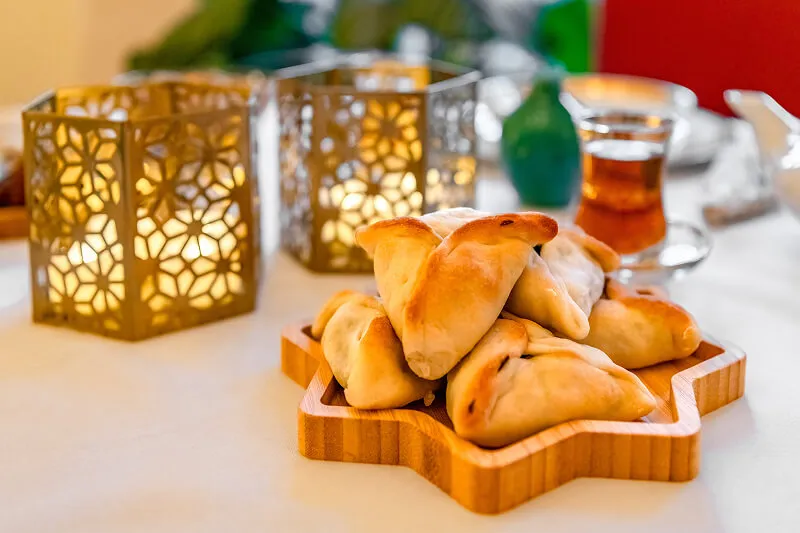
For a pastry option, Fatayer is a type of pastry filled with cheese, meat, or spinach and baked or fried to golden perfection. It is a staple delicious dish in the Middle East and, like any other culture, each country makes it their own with their style and flavored filling, a true indulgent treat that is loved by many, often enjoyed as a snack, appetizer, or a substitute for a quick sandwich.
Baked fatayer usually has a crispy and fluffy crust, while fried ones are often more oily and richer.
You can use your imagination with the shape, but we typically fold both sides of the dough inward and pinch it with your fingers to close the dough in an oblong shape. The dough is wheat flour dough; the dough can vary significantly by region and to your preference.
Fatayer with Cheese, Spinach, or Ground Beef Recipe
- 1 package of pre-made pizza dough
- 1 cup of shredded mozzarella cheese
- 1/2 cup of crumbled feta cheese
- 1/4 cup of chopped parsley
- 1/4 cup of chopped green onions
- 1/4 cup of chopped mint leaves
- Salt and pepper to taste
- Olive oil, for brushing
Preheat your oven to 375°F (190°C).
In a bowl, mix together the mozzarella and feta cheese, parsley, green onions, mint leaves, salt, and pepper.
Roll out the pizza dough into a large circle and cut it into smaller circles using a cookie cutter or glass.
Step 4:
Place a spoonful of the cheese mixture in the center of each dough circle.
Step 5:
Fold the edges of the dough up and over the filling to create a triangle shape, pinching the edges to seal.
Step 6:
Place the fatayer on a baking sheet lined with parchment paper and brush with olive oil.
Step 7:
Bake in the preheated oven for 15-20 minutes, or until golden brown and crispy.
Step 8:
Serve warm and enjoy!
- 1 package of pre-made pizza dough
- 1 lb of ground beef
- 1 small onion, finely chopped
- 2 cloves of garlic, minced
- 1 teaspoon of ground cumin
- 1 teaspoon of paprika
- Salt and pepper to taste
- Olive oil, for cooking
- Pine nuts (optional)
- Fresh parsley, finely chopped (optional)
Preheat your oven to 375°F (190°C).
In a skillet, heat some olive oil over medium heat and add the chopped onion and garlic. Cook until softened.
Add the ground beef to the skillet and cook until browned, breaking it up with a spoon as it cooks.
Step 4:
Stir in the ground cumin, paprika, salt, and pepper, and cook for another 2-3 minutes.
Step 5:
Roll out the pizza dough into a large circle and cut it into smaller circles using a cookie cutter or glass.
Step 6:
Place a spoonful of the ground beef mixture in the center of each dough circle.
Step 7:
Fold the edges of the dough up and over the filling to create a triangle shape, pinching the edges to seal.
Step 8:
Place the fatayer on a baking sheet lined with parchment paper and brush with olive oil.
Step 9:
Optional: Sprinkle some pine nuts and chopped parsley on top of the fatayer before baking.
Step 10:
Bake in the preheated oven for 15-20 minutes, or until golden brown and crispy.
Step 11:
Serve warm and enjoy!
- 1 package of frozen spinach, thawed and drained
- 1 small onion, finely chopped
- 2 tbsp olive oil
- 1 tsp salt
- 1/2 tsp pepper
- 1/2 tsp ground sumac (optional)
- 1/2 tsp ground cumin
- 1/4 tsp ground coriander
- 1/4 tsp ground cinnamon
- 1/4 cup pine nuts, toasted
- 1 package of store-bought or homemade pizza dough
Preheat your oven to 375°F (190°C).
In a large skillet, heat the olive oil over medium heat. Add the onion and cook until translucent, about 5 minutes.
Add the drained spinach to the skillet and mix well with the onion. Cook for another 5 minutes, stirring occasionally.
Step 4:
Add the salt, pepper, sumac, cumin, coriander, and cinnamon to the spinach mixture. Stir well to combine.
Step 5:
Remove the skillet from the heat and let the mixture cool slightly. Stir in the toasted pine nuts.
Step 6:
Roll out the pizza dough on a floured surface to about 1/4 inch thickness. Cut the dough into small rounds using a cookie cutter or a drinking glass.
Step 7:
Place a spoonful of the spinach mixture in the center of each dough round. Fold the edges of the dough over the filling to create a triangle shape, pinching the edges to seal.
Step 8:
Place the fatayer on a baking sheet lined with parchment paper. Bake in the preheated oven for 20-25 minutes, or until the dough is golden brown.
Step 9:
Serve the fatayer with spinach warm or at room temperature. Enjoy!
Fatteh: A Culinary Landmark
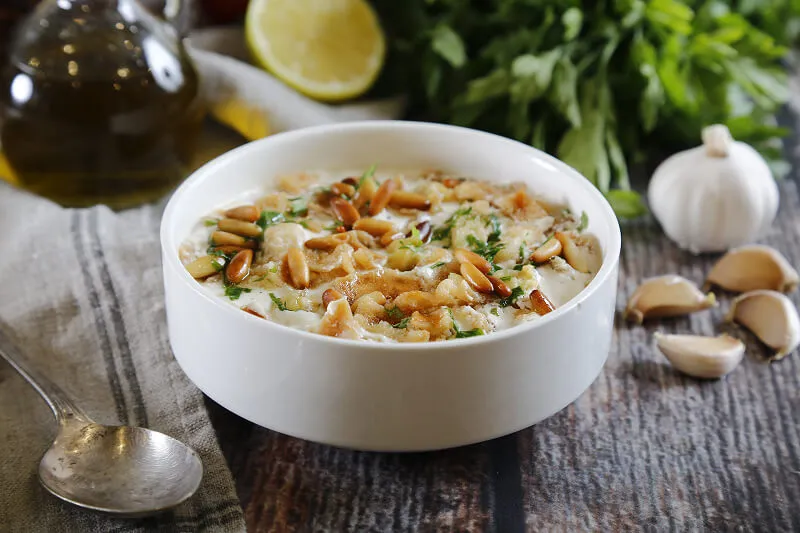
Fatteh is distinctly a Middle Eastern layered dish of rich proteins that should be enjoyed fresh, hot off the stove. It is one of my favorite dishes. It shares similarities with dishes from other cultures that utilize bread, legumes, and sauces to create hearty, layered meals.
Italian dishes are rooted in the concept of cucina povera (peasant cooking), designed to make use of leftover stale bread. While Fatteh is a layered casserole often featuring yogurt, Tuscan dishes are thicker soups or stews (Ribollita) that incorporate bread, vegetables (like tomatoes in Pappa al Pomodoro), and beans, creating a comforting, rustic meal.
Another inspired-like dish is the Mexican Chilaquiles, which uses a fried or toasted base—in this case, tortillas—similar to the crispy pita in Fatteh. The only difference, Chilaquiles are typically smothered in salsa (red or green) and topped with crema (sour cream), cheese, and often eggs or meat, offering a distinctly different flavor profile (spicy and savory) compared to the creamy, tangy yogurt sauce of Fatteh with ground beef.
Spanish Migas, which means “crumbs,” is a traditional Spanish dish that primarily uses day-old bread that is prepared by frying breadcrumbs with garlic, olive oil, and sometimes chorizo or other meats, creating a simple, textural dish.
Beyond the ingredients, Fatteh holds significant cultural importance in the Middle East. It is often considered a symbol of hospitality and generosity, frequently served at communal gatherings, family brunches, and during special occasions such as the Holy Month of Ramadan. The act of sharing a Fatteh platter embodies the region’s spirit of community and warm welcome. While each might create Fatteh to their own savoring, Fatteh showcases the rich flavors and the art of protein combination from the region. Made with chickpeas, toasted pita bread, yogurt, pine nuts, and ground beef, it is a hearty and flavorful dish that is sure to satisfy.
Kishik has a distinctive, tangy, sour flavor due to the fermentation, and a slightly nutty taste from the wheat. It’s highly nutritious, combining the protein of the dairy with the carbohydrates of the bulgur.
While Kishik is distinctively Arabic, the combination of fermented dairy and grains for preservation and consumption is a theme that recurs in many cultures across the globe, such as Tarhana in Turkey, Greece, and the Balkans. Tarhana often includes vegetables (like tomatoes, peppers, or onions) and herbs mixed into the dough before drying, giving it a broader range of flavors than the typical Kishik. While both are used in soups, Tarhana is more often associated with Turkish and Greek cuisines.
Similar to Kishik are the Fermented Cereal Porridges and Soups from Africa and India. Various African cultures have traditional fermented cereal-based foods, often consumed as porridge or beverages. Uji (Kenya) or Ogi (Nigeria) are also fermented porridges typically made from maize, millet, or sorghum.
In summary, while the practice of fermenting grains and dairy is ancient and widespread, Arabic Kishik is unique in its specific form as a dried, powdered blend of bulgur and fermented yogurt, serving both as a nutrient-dense food and a vital long-term pantry staple for the harsh winters of the region.
- 2 cups cooked chickpeas
- 2 cups plain yogurt
- 3 cloves garlic, minced
- 2 tablespoons tahini
- 1/4 cup lemon juice
- 4 pieces of pita bread, torn into bite-sized pieces
- 1/4 cup toasted pine nuts
- 1/4 cup chopped fresh parsley
- Olive oil
- Salt and pepper to taste
In a small bowl, mix together the plain yogurt, minced garlic, tahini, and lemon juice. Season with salt and pepper to taste. Set aside.
In a large mixing bowl, combine the cooked chickpeas with the torn pita bread pieces. Pour half of the yogurt mixture over the chickpeas and pita bread, and toss to combine.
Transfer the chickpea and pita bread mixture to a serving dish. Pour the remaining yogurt mixture over the top.
Step 4:
In a small saucepan, heat a bit of olive oil over medium heat. Add the pine nuts and toast until golden brown, about 2-3 minutes.
Step 5:
Sprinkle the toasted pine nuts and chopped parsley over the top of the Fatteh.
Step 6:
Drizzle with a bit more olive oil before serving. Enjoy!
Whether you are enjoying a simple breakfast at home or treating yourself to a lavish meal at a high-end restaurant, Middle Eastern breakfast dishes are sure to delight your senses and leave you feeling profoundly satisfied. The next time you sit down for breakfast, consider trying some of these dishes from the Middle East for a truly memorable dining experience.



























